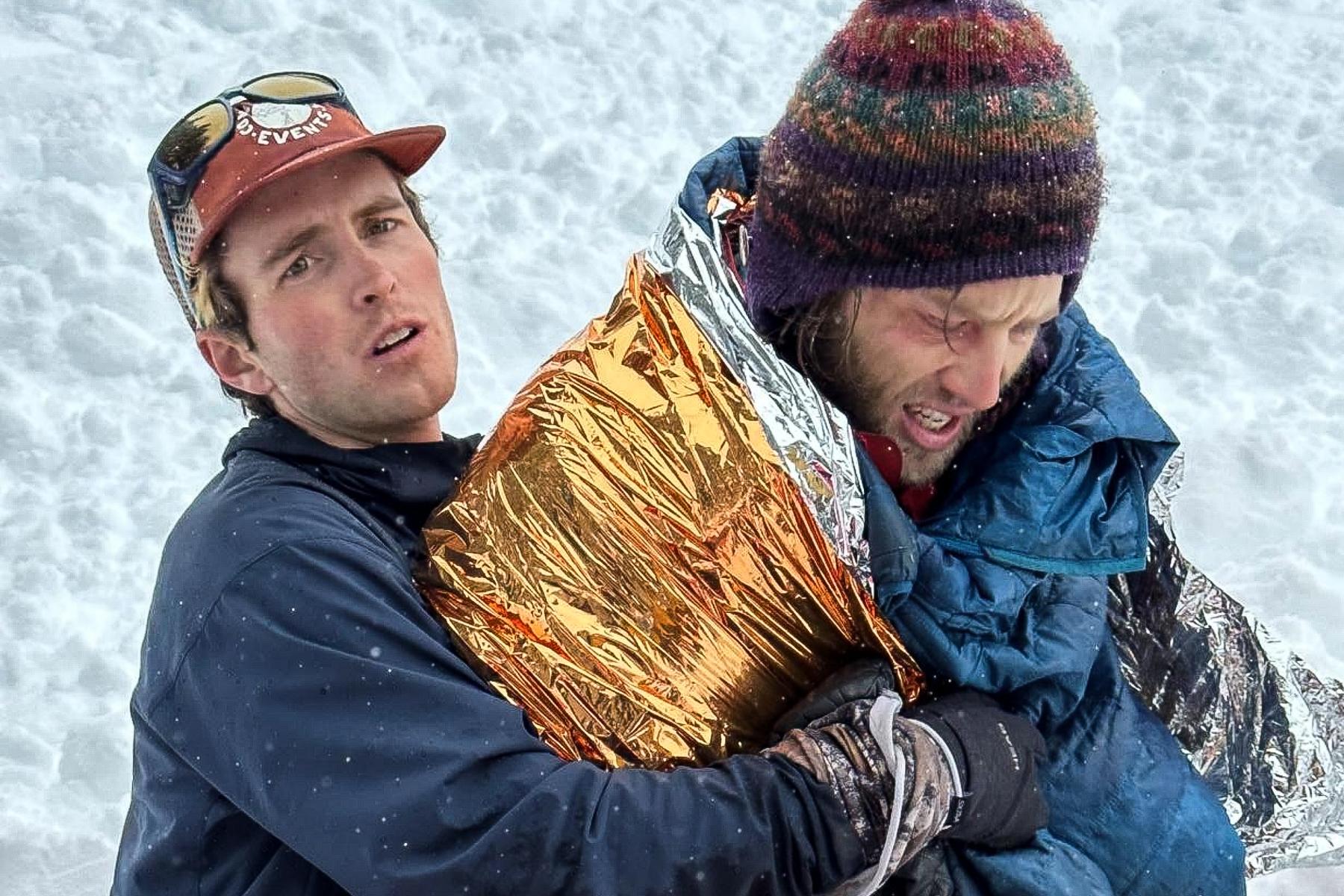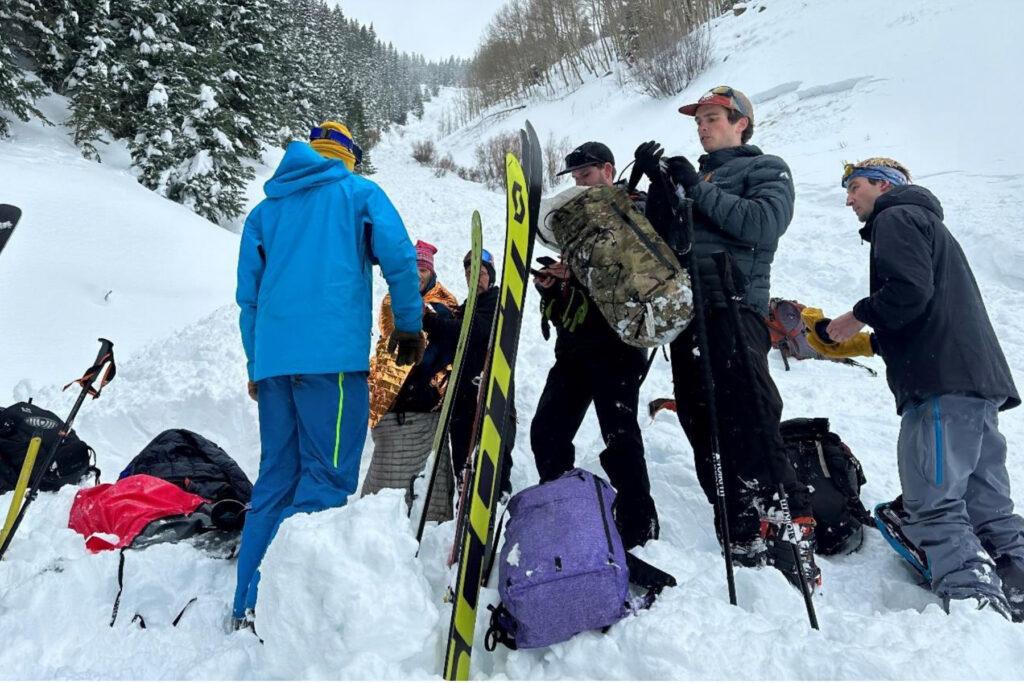
It was warm, unseasonably warm, the morning of New Year’s Eve. Scott Benge could feel it as he left his home in Telluride.
“I think one of the main mistakes I individually made was not putting enough stock in that warming trend,” he said, looking back on the day that would forever change him.
That trend had destabilized the snow. And there was a lot of it — more than a foot had fallen in the last 24 hours. Still, Benge decided to stick with his plan for the day: Backcountry skiing with a buddy in nearby Ophir, a tiny, former mining town deep in the plunging, craggy mountains.
Benge calls it “jaw-dropping beauty” but also knows its risks. Two winters before, three skiers died in a single slide not too far from Ophir. This winter, the avalanche danger in the area had been consistently considerable or higher.
“And we were definitely well aware of that and well aware of the areas that we wanted to stay away from that day,” Benge said.
A skier with Wagner Custom Skis, he met up with a photographer who also works with the Telluride-based company, Kane Scheidegger. They planned to enjoy the powder and take some pictures — and at first, that’s how it went. Scheidegger’s photos from that morning show Benge with a big smile, turning between trees heavy with snow, a white cloud billowing around him.
'It almost sounds like thunder'
After following Benge into an area the two weren’t so familiar with, Scheidegger remembers stopping to “kind of reassess at that point.”
The terrain before them was steeper than they wanted to venture into that day given the avalanche conditions, Benge explained, steeper than they had planned on.
“It’s a notorious terrain trap” that’s known for slides, he said. But they thought they could ski out of the area quickly. So they kept going, on the quest for “fresh tracks.”
Benge watched as Scheidegger skied down first. Then Scheidegger radioed that he was safe and waiting in the trees.
It was Benge’s turn. He dropped, gliding through the snow.
After three or four seconds, Scheidegger heard air release from the snowpack, and “that entire layer of snow whomps to the ground,” he said, “and it almost sounds like thunder.” Scheidegger watched as an avalanche of maybe 700 feet rushed by him in less than a minute, releasing thousands of pounds of snow down the slope.
In the chaos, he never saw Benge. That was his biggest worry.
“In an avalanche-burial scenario, you have, you know, 10 to 15 minutes at the most to recover somebody,” Scheidegger said.
Luckily, both of them were wearing avalanche beacons, gadgets that can transmit and pick up the location of someone buried in snow. Scheidegger put his into “search” mode — and got to work.
'It's much scarier living through that than you can ever imagine'
Benge was stuck under at least five feet of what felt like concrete on top of him. Both men had gone through avalanche-safety training, and while being pushed down the mountainside, Benge had tried to do what he had learned: put his hands in front of his face to create an air pocket, to hopefully prolong his life just a few more minutes. He never got the chance.
By the time the slide stopped, “I couldn't move a finger,” he said.
“I mean, I couldn't move anything.”
His airway was completely filled with snow.
“It’s always been one of my biggest nightmares,” Benge said. “And yes, I've thought about it a lot, and I can tell you it's much scarier living through that than you can ever imagine.”
He knew he couldn’t afford to panic, to scream, to get his heart rate up. For all the terror, he described it as a “more of a calm time.”
During those 20 or 30 seconds he stayed awake, he figured he wasn’t going to make it, that he would die right there. All he could do was hope people around him would find him in time.
“I thought about my mom and my dog and my fiancé,” Benge said.
Then he passed out.
Searching in a sea of snow
Meanwhile, Scheidegger was working his way through the slide path, avalanche beacon in hand, listening for that little “beep” that would tell him his friend was close by. He had hoped he’d see a gloved hand or a ski boot, but there was no physical sign of Benge in the sea of crumpled snow before him.
Scheidegger kept moving down and down, going hundreds of feet until that signal went off. That’s when he knew Benge was somewhere within about five feet of him. He got out his probe, basically a long, folding pole, and started poking. Finally, he hit something that felt hard, that felt like a person. He got out his shovel and started digging.
For at least five minutes, he dug alone. Then another skier showed up, Sheamus Croke, who had heard the distress call over the radio. When he arrived, only Benge’s hand had been exposed. The rest of him was still completely encased, with the snow starting to harden around his body, making the excavation even more difficult.
Croke knew that people can hear you under the snow.
“So we're screaming at Scott before we even got him out of there, even though I didn't know he was unconscious,” he said.
They worked to uncover Benge’s face as quickly as possibly. Soon, they were digging snow out of his mouth. They were eventually joined by others who had also heard about the avalanche over the radio.
Scheidegger remembers how relieved they felt when they finally freed him enough to clear Benge’s airway, “and he took this really kind of deep, gurgly, labored breath.”
Benge was still pretty unresponsive, though, for the next four or five minutes, as the group worked to release him, still clicked into his skis, from the snow’s grasp.
When he finally opened his eyes, he saw he was surrounded by about a dozen people.
“And I remember just looking up at the slide, and I just couldn't believe it,” he said.

'Guilt and embarrassment'
That’s his first memory, combined with being cold with a fierceness he had never felt before. The group of skiers tried to warm him up with various articles of clothing and a space blanket.
They asked him if he knew what day it was, if he knew his name, if he was hurt anywhere. Benge kept saying he felt no pain, and finally, they called off the search-and-rescue team that was going to head out.
Benge was “showing signs that he was actually gonna be able to physically ski out on his own two feet,” Scheidegger said, “which I think is amazing.”
And getting out of there was essential. They were still in avalanche terrain, after all.
As adrenaline pumped through his body, a “convoy of people” helped him ski down, Benge said. He remembers that, but not much else — except for what he felt.
“Guilt and embarrassment, you know, that I made a decision that led to this,” he said.
He described himself as being in a grieving period for several weeks. He still sounds humbled by the knowledge of all the things that had to go right in order for him to ski away that day. It took the quick actions and level-headedness of Scheidegger and Croke, “and then all of the other people recreating in the area at that time, you know, really saved my life,” he said.
Returning to the slope
Two weeks later, Benge returned to the slope, to a safe spot where he could view the place he almost died.
“Kind of looking at the terrain really made my stomach turn and was very emotional,” he said.
He brought along Croke, who thinks it’s admirable that Benge wants to talk about his experience.
It’s not easy to be open about something like this, Croke said. He believes it’s important to change the narrative from one of blame to, “Hey, everybody makes mistakes. This turned out really well. How can we — how can the whole community benefit and learn from that?”
Scheidegger has seen that learning already begin in the small community of locals dedicated to exploring the backcountry. They’ve rehashed the whole thing, looking at how critical teamwork was — and how vital it is that people practice every winter with their safety equipment and rescue skills.
Avalanche beacons. Shovels. Probes. Scheidegger has seen first-hand that these can be the difference between life and death.
The mountains are “big and unforgiving, and they need to be respected,” he said. “Ultimately, the mountains call the shots, I think. So it’s important to listen to them.”
'It was almost never again'
All the people who were there that day carry this experience with them, but Benge more than anyone. He remembers how emotional it was to recount it to the people he cares most about.
“I mean, just telling everyone how much I love them and how much they mean to me,” he said, choking up just a bit. “Cause, you know, it was very — it was almost never again.”
Like so many people in the Telluride community, he’s lost friends to avalanches. Now, as he continues to walk through his own near-death experience, he’s surrounded by others who understand the toll that takes.
“The support's just been so appreciated and pretty incredible,” he said.
It’s a dangerous thing backcountry skiers do, Benge knows. But for him, there’s no substitute for it — skiing powder with friends in remote, gorgeous places. So he’ll keep doing this thing he loves, just more cautiously than before
Even now, he says what backcountry skiing gives him, “is more than most things in life.”








